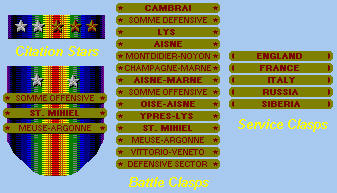

By Act of Congress, 09 Jul 1918, a 3/16-inch silver 'Citation Star' was
authorized to denote receipt of a citation for gallantry in action, in the First
World War and retroactive to the Civil War, of a degree less than that required
for award of the Medal of Honor or the Distinguished Service Cross.
Citation Stars take precedence and are to be worn above and to the wearer's
right of other devices.
On 08 Aug 1932, Congress revised the Act to create the
Silver Star medal.
The new medal incorporated the silver Citation Star as its central feature.
Veterans were authorized the replacement decoration, but had to discontinue wear
of Citation Stars on their Victory Medal (or other Service Medals for USN and
USMC personnel).
Bronze clasps, 1/8-inch by 1-1/2 inches, with the names of the thirteen campaigns of the US Army during the First World War and one titled "Defensive Sector", worn on the suspension ribbon of the Victory Medal. These are distinguished from Service Clasps by the star at each end of the inscription. A bronze Service Star is worn on the service ribbon of the Victory Medal in lieu of the clasp.
Battle Clasps denote actual participation in or direct support of
troops involved in each campaign. The inclusive dates of each campaign period
can be found at the entry for
The Victory Medal,
World War I, on my Service Medals page.
Bronze clasps, 1/8-inch by 1-1/2 inches, with the name of the country of service during the First World War, worn on the suspension ribbon of the Victory Medal when no Battle Clasps were awarded. These are distinguished from Battle Clasps by the lack of the star at each end of the inscription. Service Clasps denote service of at least 30 days in the country inscribed.